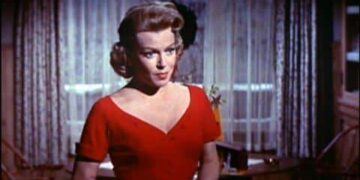Grace Metalious, a renowned American author, made a lasting impact on both literature and cinema during her lifetime. Born and raised in a small New Hampshire town, Metalious drew inspiration from her own experiences and the people she encountered. Her novels delved into the complexities of small-town life, exploring themes of class, social hierarchy, and scandal. Metalious’s most famous work, “Peyton Place,” not only became a national bestseller but also revolutionized the world of cinema with its daring screen adaptation. In this article, we will delve into Metalious’s biography, examine the connection between literature and cinema, and explore the profound influence she had on both mediums.
Grace Metalious’s Biography: A Glimpse into Her Life and Career
Grace Metalious was born on September 8, 1924, in Manchester, New Hampshire. Growing up in a working-class family, Metalious developed a keen sense of observation and an understanding of the dynamics within a community. After completing high school, she attended the University of New Hampshire, where she met her future husband, George Metalious.
Metalious began her writing career by contributing short stories to magazines, but it was her first novel, “Peyton Place,” that catapulted her to fame. Published in 1956, the book caused a sensation with its explicit portrayal of small-town scandals and secrets. The success of “Peyton Place” led to Metalious becoming one of the most talked-about authors of her time.
Exploring the Connection Between Literature and Cinema
The relationship between literature and cinema is a complex and intricate one. While some adaptations fail to capture the essence of the original work, others manage to bring the story to life in a captivating and visually stunning manner. Metalious’s “Peyton Place” falls into the latter category, as the screen adaptation became a groundbreaking moment in cinema history.
Directed by Mark Robson, the film version of “Peyton Place” was released in 1957 and was an instant success. Starring Lana Turner, Lee Philips, and Hope Lange, the movie brought to life the scandalous events and gripping narratives of the novel. It was praised for its boldness in addressing taboo subjects such as rape, incest, and abortion, which were rarely depicted on the silver screen at the time. The success of “Peyton Place” paved the way for future adaptations of popular novels and showcased the potential of literature to inspire and captivate audiences in a new medium.
The Screen Adaptation of Peyton Place: A Groundbreaking Moment in Cinema History
The screen adaptation of “Peyton Place” was a turning point in the history of cinema. Prior to its release, movies tended to shy away from controversial topics and instead focused on more traditional narratives. However, “Peyton Place” shattered the conventional norms, bringing to light the dark underbelly of small-town America.
The film not only addressed taboo subjects but also highlighted the power of storytelling to provoke thought and challenge societal norms. By adapting Metalious’s novel, the filmmakers were able to expose a wider audience to the themes and ideas explored in the book. This groundbreaking moment in cinema history demonstrated the potential of literature to be transformed into a visual medium that could engage and captivate audiences on a whole new level.
Hidden Gems and Trivia About Grace Metalious’s Books
While “Peyton Place” remains Grace Metalious’s most famous work, she also wrote several other novels that deserve recognition. One hidden gem among her books is “Return to Peyton Place,” the sequel to her debut novel. Published in 1958, this continuation of the Peyton Place saga delves deeper into the lives of the characters and explores the consequences of their actions.
Another lesser-known work is “No Adam in Eden,” published in 1963. This novel revolves around the lives of four women who find themselves trapped in unfulfilling marriages. Metalious’s exploration of female agency and the constraints of societal expectations makes this book a compelling read.
Metalious’s books were often filled with memorable quotes that resonated with readers. One of her most famous lines comes from “Peyton Place”: “A girl must marry for love, and keep on marrying until she finds it.” This quote encapsulates Metalious’s exploration of love, relationships, and the complexities of human emotions.
Love Life and Friendships: The Personal Side of Grace Metalious
Behind the scenes, Grace Metalious led a tumultuous life filled with both triumphs and heartbreaks. While married to George Metalious, she engaged in numerous affairs, including one with her editor, Walter Weir. These personal relationships had a profound impact on her writing and added depth and complexity to her characters’ romantic entanglements.
Metalious also formed close friendships with other writers, including Shirley Jackson and Dorothy Parker. These connections provided her with a support system and a space to discuss the challenges and triumphs of being a female writer in a male-dominated industry.
Rich or Poor: Themes of Class and Social Hierarchy in Metalious’s Works
One of the recurring themes in Grace Metalious’s novels is the exploration of class and social hierarchy. Metalious, who grew up in a working-class family, had a keen understanding of the dynamics between different social classes. Her novels often portrayed the stark contrasts between the wealthy elite and the struggling lower classes, highlighting the disparities and injustices that existed within society.
In “Peyton Place,” Metalious delves into the lives of characters from different social backgrounds, exposing the prejudices and judgments that arise from these divisions. Through her writing, Metalious challenges the notion that wealth and social status determine a person’s worth, emphasizing the importance of empathy and understanding.
Best Quotes from Grace Metalious’s Novels
Grace Metalious’s novels are known for their memorable quotes that capture the essence of her characters and the themes she explores. Here are a few standout quotes from her works:
- “Small towns are not for people like me.” – Peyton Place
- “Behind every scandal, there is a story waiting to be heard.” – Return to Peyton Place
- “Love can be a destructive force, tearing lives apart or mending broken hearts.” – No Adam in Eden
- “In a society built on secrets, truth becomes the ultimate rebellion.” – The Tight White Collar
- “The measure of a person’s character is not their wealth, but their capacity for kindness.” – The Other Side of Midnight
These quotes showcase Metalious’s ability to encapsulate complex emotions and societal issues in concise and thought-provoking phrases.
The Main Settings of Grace Metalious’s Books: A Journey Through Different Locations
Grace Metalious’s novels transport readers to various settings, each with its own unique atmosphere and sense of place. From the small New England town of Peyton Place to the glamorous streets of New York City, Metalious’s books take readers on a journey through diverse landscapes and communities.
“Peyton Place” is set in a fictional New England town, drawing inspiration from Metalious’s own experiences growing up in Gilmanton, New Hampshire. The vivid descriptions of the town and its inhabitants bring the setting to life, immersing readers in the world of Peyton Place.
In “No Adam in Eden,” Metalious explores the contrasting worlds of suburban Connecticut and the bustling streets of New York City. The juxtaposition of these settings highlights the differences in social class and the challenges faced by the characters as they navigate between the two.
The First Book by Grace Metalious and Its Significance
Grace Metalious’s first novel, “Peyton Place,” was a groundbreaking work that challenged societal norms and pushed the boundaries of what was considered acceptable in literature. Published in 1956, the book caused a sensation with its frank portrayal of taboo subjects such as sexual assault, incest, and abortion.
“Peyton Place” not only became an instant bestseller but also sparked discussions about censorship and the role of literature in addressing controversial topics. Metalious’s willingness to tackle these issues head-on paved the way for future authors to explore similar themes in their own works.
The Last Book by Grace Metalious: A Reflection on Her Legacy
Grace Metalious’s final novel, “The Tight White Collar,” was published in 1969, just two years before her untimely death at the age of 39. The book tells the story of a young woman caught in a web of deceit and corruption in a small New England town.
While “The Tight White Collar” did not receive the same level of acclaim as Metalious’s earlier works, it serves as a testament to her enduring legacy. The novel continues to explore the themes that defined Metalious’s writing career, including the dark underbelly of small-town life and the struggles faced by women in a patriarchal society.
Other Artists Who Were Inspired by Grace Metalious’s Work
Grace Metalious’s writing had a profound impact not only on readers but also on other artists across various mediums. Her bold exploration of taboo subjects and her unflinching portrayal of human emotions resonated with many, inspiring them to create their own works of art.
One notable artist inspired by Metalious’s work is photographer Diane Arbus. Arbus’s portraits often captured the raw and complex emotions of her subjects, much like Metalious’s characters. Arbus’s photographs invite viewers to confront the darker aspects of human nature, much like Metalious’s novels.
Recommended Books and Authors for Fans of Grace Metalious’s Writing
If you are a fan of Grace Metalious’s writing and are looking for similar authors and books to explore, here are a few recommendations:
- “Peyton Place” by Grace Metalious (1956)
- “The Group” by Mary McCarthy (1963)
- “The Bell Jar” by Sylvia Plath (1963)
- “Revolutionary Road” by Richard Yates (1961)
- “The Catcher in the Rye” by J.D. Salinger (1951)
These books share a similar exploration of societal norms, the complexities of human relationships, and the challenges faced by individuals in conforming to societal expectations.
Conclusion: The Enduring Influence of Grace Metalious on Literature and Cinema
Grace Metalious’s impact on both literature and cinema cannot be overstated. Through her novels, she fearlessly delved into the dark underbelly of small-town life, challenging societal norms and pushing the boundaries of what was considered acceptable in literature. Her works continue to captivate readers with their vivid characters, compelling narratives, and thought-provoking themes.
The screen adaptation of “Peyton Place” was a groundbreaking moment in cinema history, showcasing the power of literature to inspire and captivate audiences in a new medium. Metalious’s influence can be seen in the works of other artists who were inspired by her writing, as well as in the continued popularity of her novels.
Grace Metalious’s legacy as a trailblazing author and her exploration of taboo subjects continue to resonate with readers and viewers alike. Her work serves as a reminder of the power of storytelling to provoke thought, challenge societal norms, and inspire change.









